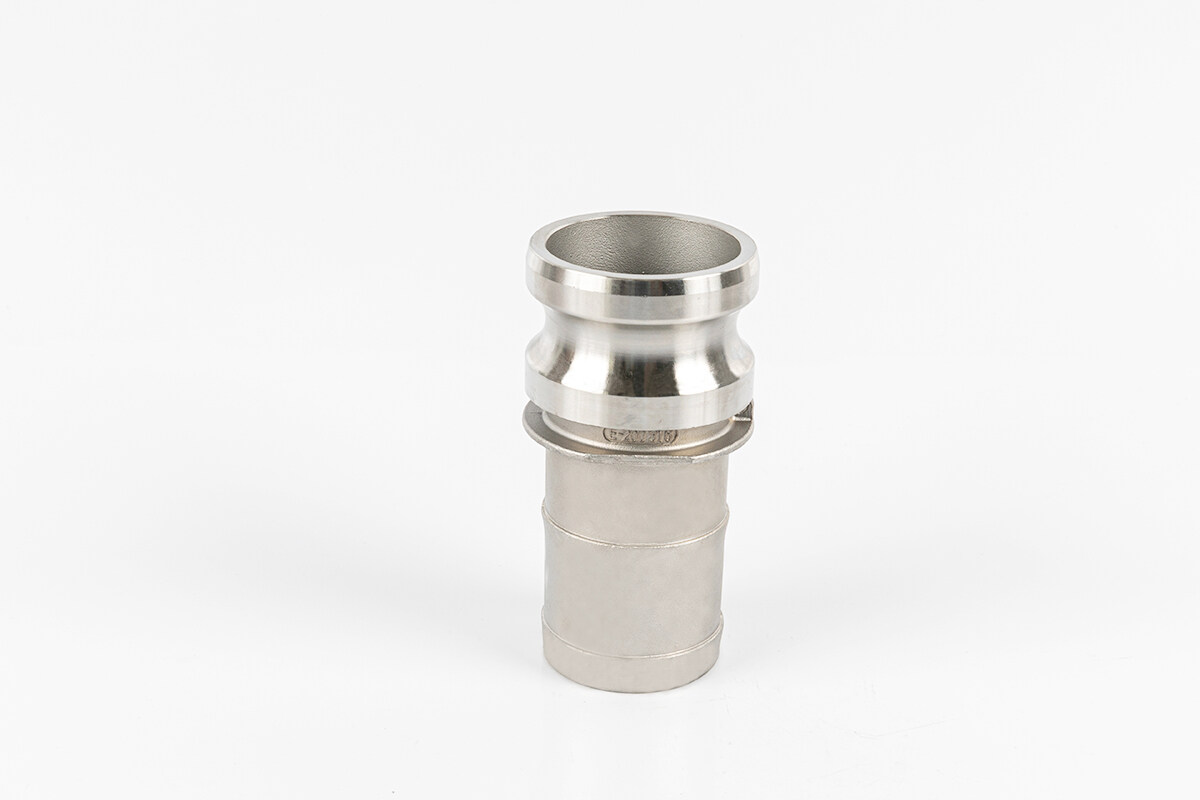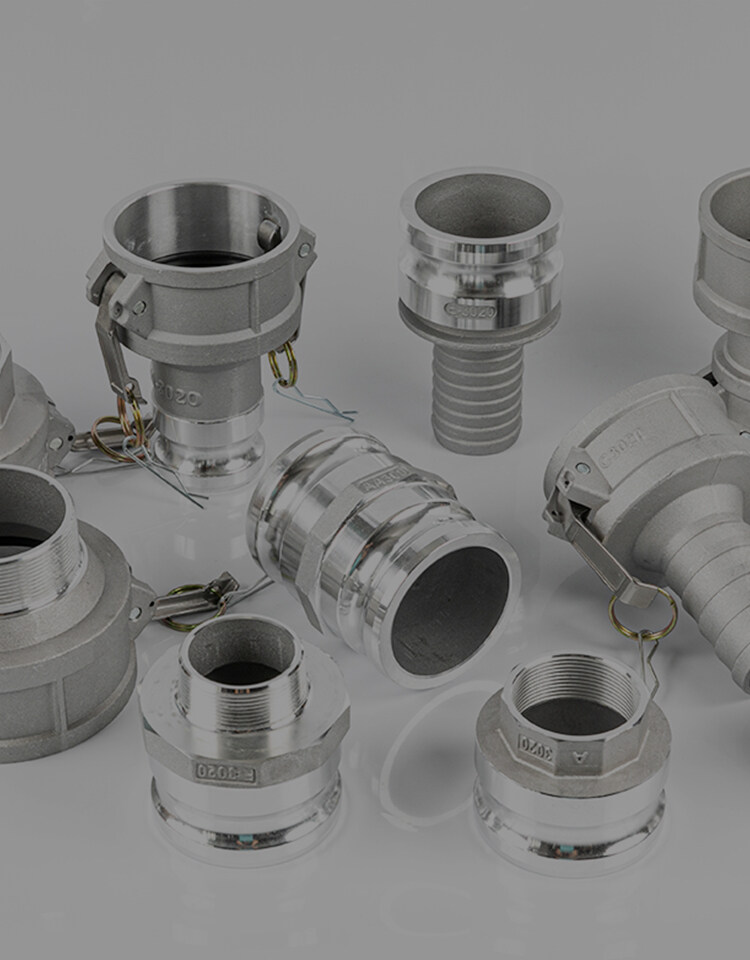Email format error
Email cannot be empty
Email already exists
6-20 characters(letters plus numbers only)
The password is inconsistent
Email format error
Email cannot be empty
Email does not exist
6-20 characters(letters plus numbers only)
The password is inconsistent

News
Here, you can describe a piece of text you want to express

The Comprehensive Guide to Aluminum Cam Lock Fittings
Welcome to our in-depth exploration of aluminum cam lock fittings, the unsung heroes of fluid management systems. These fittings are not only pivotal in ensuring secure and leak-free connections but also embody efficiency and adaptability. Whether you’re a seasoned engineer or new to the world of fluid handling, this guide will illuminate the myriad of benefits that aluminum cam lock fittings bring to the table.
What Are Aluminum Cam Lock Fittings?
Aluminum cam lock fittings, also known as cam and groove couplings, are a type of quick-connect fitting used in various industries to connect hoses and pipes swiftly and securely. These fittings consist of a male (plug) and a female (coupler) end that lock together with a simple lever action, eliminating the need for threading or flanges. The ease of operation makes them ideal for applications where frequent changes are necessary or in emergency situations where time is of the essence.
The Advantages of Using Aluminum Cam Lock Fittings:
Lightweight Construction: One of the most significant benefits is their lightweight nature. Aluminum, as a material, offers a remarkable strength-to-weight ratio, which is highly advantageous in applications where overall weight is a concern. The reduced weight of these fittings makes them easier to handle, transport, and install, especially when compared to heavier alternatives. This can lead to reduced labor costs and less strain on workers during manual handling.
Robust Durability: Despite their lightness, the lock fittings do not sacrifice strength or durability. Aluminum is known for its excellent mechanical properties, including its ability to withstand substantial loads and pressures. This robustness ensures that the cam lock fittings can maintain their integrity under demanding conditions, contributing to the reliability and longevity of the systems in which they are used.
Corrosion Resistance: Aluminum naturally forms a protective oxide layer when exposed to the atmosphere, which shields the material from further corrosion. This inherent resistance to corrosion is particularly beneficial when the cam lock fittings are used with fluids that can be corrosive, such as certain chemicals. It also makes them suitable for outdoor applications or environments where they may be exposed to moisture, such as in marine or agricultural settings.
Compatibility with Various Fluids: They are versatile and can be used with a wide range of fluids. They are commonly used for transferring water, oils, fuels, and certain chemicals. The compatibility with various substances makes them a flexible solution for many fluid handling systems, from industrial manufacturing to emergency services.
Cost-Effectiveness: When it comes to cost, the cam lock fittings are more economical than those made from materials like stainless steel or brass. The lower cost does not come at the expense of quality or performance, making aluminum fittings an attractive option for businesses looking to optimize their operations while keeping expenses in check. The cost savings can be particularly significant when large quantities of fittings are required.
Quality Without Compromise: Choosing the cam lock fittings means opting for a solution that provides quality without compromise. Despite their lower cost, these fittings meet high standards of performance and reliability. They are manufactured to precise specifications and are subject to stringent quality control measures, ensuring that they perform as expected in critical applications.
Industries That Benefit from Aluminum Cam Lock Fittings:
The cam lock fittings are a critical component in a multitude of industries due to their reliability, ease of use, and versatility. Here’s a closer look at how various sectors benefit from these fittings:
Agriculture: In the agricultural sector, irrigation systems are vital for crop cultivation. They are widely used to quickly connect and disconnect hoses and pipes in these irrigation systems. Their durability ensures they can withstand the outdoor elements and the corrosive nature of various fertilizers and pesticides.
Oil and Gas: The oil and gas industry relies on the safe and efficient transfer of fuels. They are used in this sector due to their ability to maintain a secure connection under high pressure and their resistance to the corrosive properties of crude oil and other hydrocarbons.
Chemical Manufacturing: Safety is paramount in the chemical manufacturing industry, where the handling of hazardous substances is routine. They provide a secure seal that can prevent leaks and spills, which is essential for protecting workers and the environment.
Firefighting: In firefighting, quick and reliable hose connections are crucial. They allow firefighters to rapidly connect hoses to hydrants or pumps, which can be the difference between a controlled burn and a devastating blaze.
Water Treatment: The cam lock fittings are also used in water treatment plants. Their corrosion resistance is beneficial for handling various types of treated and untreated water, and their quick-connect capability facilitates easy maintenance and system reconfiguration.
Transportation: The transportation of liquids, such as in tanker trucks, often utilizes the cam lock fittings for loading and unloading fluids. Their lightweight nature reduces the overall weight of the transport vehicles, and their secure locking mechanism prevents leaks during transit.
The adaptability to different environments, including extreme temperatures and pressures, makes them invaluable to these industries. Their performance under pressure ensures that they can handle the rigorous demands of each sector, providing a reliable solution for managing fluids.
How to Choose the Right Aluminum Cam Lock Fittings?
Selecting the right aluminum cam lock fitting is essential for ensuring a secure and efficient connection in your fluid handling system. Here are the key factors to consider when choosing the right fitting:
Diameter Compatibility: The diameter of the hoses or pipes you’re connecting will determine the size of the cam lock fitting you need. It’s crucial to choose a fitting that matches the inner diameter of your hose to ensure a tight seal and prevent leaks.
Fluid Type: The type of fluid being transferred can affect the choice of fitting. While aluminum is resistant to many substances, it’s important to ensure compatibility with the specific fluids in your system, especially if they are corrosive or abrasive.
Working Pressure: The pressure at which your system operates must be within the pressure rating of the aluminum cam lock fitting. Choosing a fitting with an appropriate pressure rating is critical to prevent failures and ensure the safety of the system.
Environmental Conditions: Consider the environmental conditions where the fittings will be used. Factors such as temperature extremes, exposure to UV light, and the presence of corrosive elements can impact the performance and lifespan of the fitting.
Quality and Standards: Ensure that the aluminum cam lock fittings you select meet industry standards and quality certifications. High-quality fittings are more likely to provide a reliable connection and have a longer service life.
Installation Tips for Aluminum Cam Lock Fittings?
Proper installation is crucial to ensure a leak-free system and to maintain the integrity of the connection. Here are detailed steps and tips for installing these fittings:
Inspection: Before installation, inspect each fitting for any signs of damage, such as cracks, dents, or thread damage. Pay special attention to the gaskets, which should be intact and free from tears or deformities.
Gasket Placement: Verify that the gaskets are properly seated in the grooves of the female coupler. These gaskets are essential for creating a tight seal and preventing leaks.
Alignment: Carefully align the male adapter with the female coupler. Misalignment can cause damage to the threads or gaskets and may result in a poor seal.
Connection: Insert the male end into the female coupler. Hold the coupler steady and close the cam arms in a smooth, controlled motion. The arms should lock into place with a firm snap, indicating a secure connection.
Tightening: Do not use tools to force the cam arms closed, as over-tightening can damage the gaskets or the fittings themselves. The design of cam lock fittings allows for a secure connection without the need for excessive force.
Final Check: Once connected, give a gentle tug to ensure the fittings are locked together properly. Check around the connection for any gaps or misalignment.
Maintenance and Care for Aluminum Cam Lock Fittings?
To ensure the longevity and proper function, regular maintenance is necessary. Here are some maintenance and care tips:
Visual Inspection: Routinely inspect the fittings for signs of wear, such as scratches, corrosion, or gasket deterioration. Look for any signs of leakage, which could indicate a compromised seal.
Cleaning: Keep the fittings clean by removing any debris, dirt, or residual fluids. This helps prevent contamination of the system and ensures a clear path for fluid transfer.
Gasket Integrity: Check the gaskets regularly for wear or damage. Replace any gaskets that show signs of deterioration to maintain a leak-free seal.
Lubrication: Periodically lubricate the cam arms to ensure they operate smoothly. Use a suitable lubricant that is compatible with the gasket material and the fluids in the system.
Part Replacement: If any part of the fitting is worn or damaged, replace it immediately. Using damaged fittings can compromise the system’s safety and efficiency.
Troubleshooting Common Issues with Aluminum Cam Lock Fittings?
Even with proper installation and maintenance, issues can arise with the cam lock fittings. Here’s how to troubleshoot some common problems:
Leaks: If you notice a leak at the connection, first check the gaskets for wear or damage. Replace any defective gaskets. Ensure that the fittings are correctly aligned and that the cam arms are fully closed.
Pressure Drops: A sudden drop in pressure could indicate a clogged fitting or an incorrect fitting size for the application. Inspect the interior of the fittings for blockages and clean as necessary. Verify that the fitting size matches the system’s requirements.
Misalignment: If the fittings are not properly aligned during installation, it can lead to leaks or difficulty in connecting. Ensure that the fittings are supported adequately and that the connection is straight. Realign the fittings if necessary.
The Role of Aluminium Coupling Suppliers:
Aluminium coupling suppliers play a crucial role in the distribution and provision of high-quality cam lock fittings. Their responsibilities and services extend beyond mere sales; they are partners in ensuring that the needs of various industries are met with precision and expertise. Here’s a detailed look at the role of these suppliers:
Product Range: A reliable supplier should stock a comprehensive range of aluminum coupling sizes and types to cater to the diverse requirements of different industries. This includes various diameters, thread types, and configurations to ensure compatibility with a wide array of systems.
Specifications: Suppliers must provide clear and accurate specifications for their products. This includes dimensions, pressure ratings, compatibility with different fluids, and temperature ranges. Such information is vital for customers to select the correct fittings for their specific applications.
Quality Assurance: High-quality aluminum couplings are essential for the safety and efficiency of fluid transfer systems. Suppliers should adhere to strict quality control standards and offer products that meet or exceed industry certifications and regulations.
Expertise: Knowledgeable staff can significantly enhance the customer experience. Suppliers should employ experts who can offer guidance on product selection, installation tips, and troubleshooting advice. This expertise is invaluable in helping customers avoid common pitfalls and ensure their systems operate optimally.
Custom Solutions: In some cases, standard fittings may not suffice. Reliable suppliers should be able to provide custom solutions or modifications to meet unique system requirements or to address challenging applications.
After-Sales Support: The supplier’s role doesn’t end with the sale. Offering robust after-sales support, including warranty services, product support, and replacement parts, is essential for maintaining long-term customer relationships.
Aluminium Couplings vs. Other Materials:
Aluminum cam lock fittings offer distinct advantages when compared to couplings made from other materials such as stainless steel or brass. Here’s a detailed comparison:
Weight: Aluminum is significantly lighter than stainless steel and brass, which makes aluminum couplings easier to handle and reduces the overall weight of the system. This can be particularly beneficial in applications where weight savings are crucial, such as in portable equipment or aerospace applications.
Strength: Despite its lightness, aluminum possesses a high strength-to-weight ratio. It provides sufficient strength for many applications, making it a reliable choice for a variety of fluid transfer systems.
Corrosion Resistance: Aluminum naturally forms an oxide layer that protects it from corrosion. This characteristic makes aluminum couplings particularly suitable for use in environments where they may be exposed to corrosive substances or varying weather conditions.
Cost: Generally, aluminum couplings are more cost-effective than those made from stainless steel or brass. This cost advantage makes aluminum an attractive option for projects with tight budgets without compromising the system’s integrity.
Thermal Conductivity: Aluminum has better thermal conductivity than stainless steel, which can be advantageous in applications where heat dissipation is a factor.
Machinability: Aluminum is easier to machine than stainless steel, allowing for more intricate designs and potentially lower manufacturing costs.
Aluminium Hose Fittings for Various Applications?
Aluminum hose fittings are designed to meet the diverse needs of multiple industries and applications. They are crafted in a variety of shapes and sizes to ensure compatibility with different hose diameters and types, as well as to address specific functional requirements. Here’s a detailed look at the range of aluminum hose fittings available:
Standard Couplers: These are the most common type of aluminum hose fittings, used to connect hoses to each other or to a tap, pump, or other equipment. They typically feature a male adapter and a female coupler with cam arms for easy and secure locking.
Adapters: Adapters are used to transition between different sizes or types of connections. They can be male-to-female, female-to-male, or even between different thread types, ensuring that hoses with different end fittings can be connected.
Elbows: Elbow fittings are used when hoses need to be connected at an angle. This can help prevent kinking and wear on the hose when the path of the fluid transfer system changes direction.
Reducers: Reducer fittings are used to connect hoses of different diameters, allowing for a smooth transition in flow size within a system.
End Caps: End caps are used to seal the end of a hose or pipe, which is useful for testing systems or when hoses need to be temporarily sealed.
Plugs and Dust Caps: These fittings are used to protect the ends of disconnected hoses or fittings from contaminants and to prevent leakage when not in use.
Each type of fitting is designed for easy use and quick connection, ensuring that hoses can be securely attached with minimal effort and without the need for tools. The versatility of aluminum hose fittings makes them suitable for a wide range of applications, including water delivery, chemical transfer, fuel supply, and many others.
The Future of Aluminum Cam and Aluminum Cam Lock Technology:
The aluminum cam lock fitting industry is poised for growth and innovation. Here’s what the future may hold for this technology:
Material Innovations: Research into new aluminum alloys and surface treatments could lead to fittings with even greater strength, corrosion resistance, and durability, expanding their suitability for more demanding applications.
Design Improvements: As industries evolve, there is a continuous demand for more efficient and user-friendly designs. Future cam lock fittings may feature ergonomic enhancements, improved sealing mechanisms, and even smart technology integration for monitoring and control.
Manufacturing Advancements: With the rise of technologies such as 3D printing and precision CNC machining, the production of cam lock fittings may become more cost-effective and flexible. This could lead to the ability to produce custom fittings more quickly and affordably.
Environmental Considerations: As sustainability becomes increasingly important, the industry may focus on developing more eco-friendly manufacturing processes and recycling programs for aluminum fittings.
Regulatory Compliance: The cam lock fittings will continue to evolve to meet the changing regulatory standards and safety requirements of various industries, ensuring that they remain a trusted and compliant option for fluid transfer systems.
Global Market Expansion: As developing countries continue to industrialize, the demand for reliable and affordable fluid transfer solutions is expected to increase, potentially leading to a broader global market for aluminum cam lock fittings.
Conclusion:
Aluminum cam lock fittings, or cam and groove couplings, are quick-connect devices used to attach hoses and pipes in fluid systems. They are valued for their lightweight, durability, corrosion resistance, and cost-effectiveness. These fittings are widely used in industries like agriculture, oil and gas, chemical manufacturing, firefighting, water treatment, and transportation. Selection of the right fitting involves considering hose diameter, fluid type, pressure, and environmental factors. Proper installation and maintenance are key to their performance. Aluminum fittings offer advantages over heavier and more expensive materials like stainless steel or brass. The future of aluminum cam lock technology is promising, with potential advancements in design, manufacturing, and sustainability expected to drive market growth.

